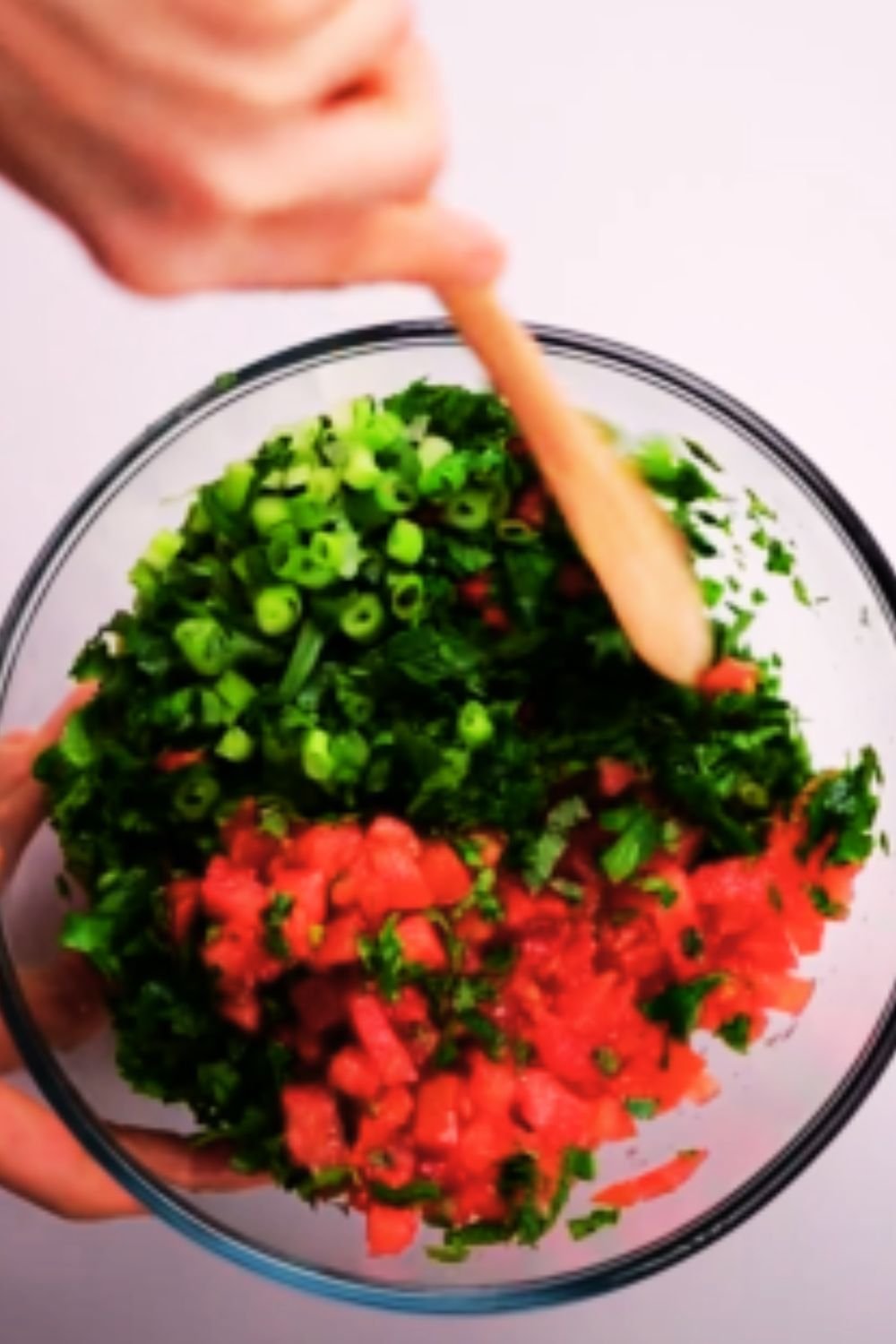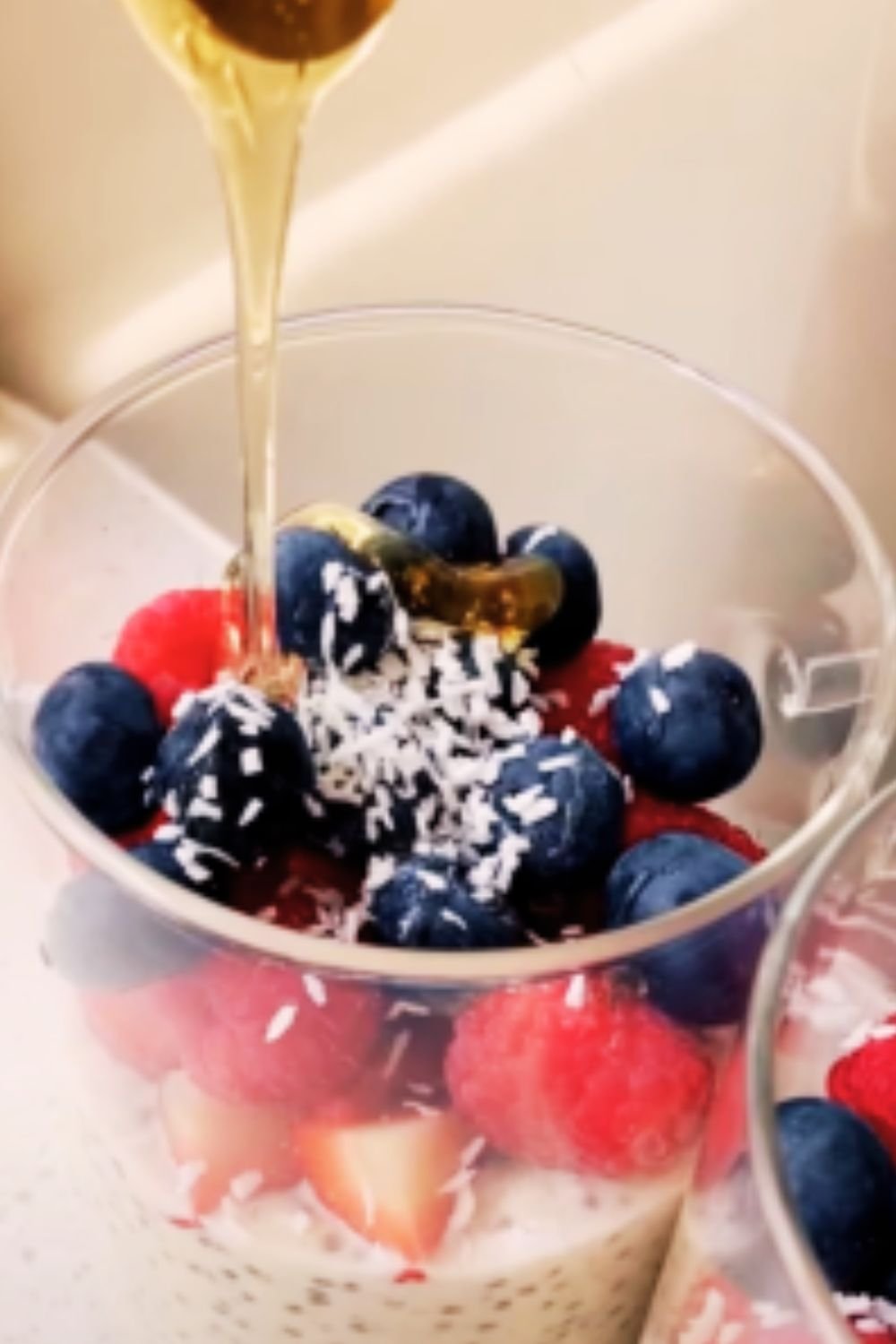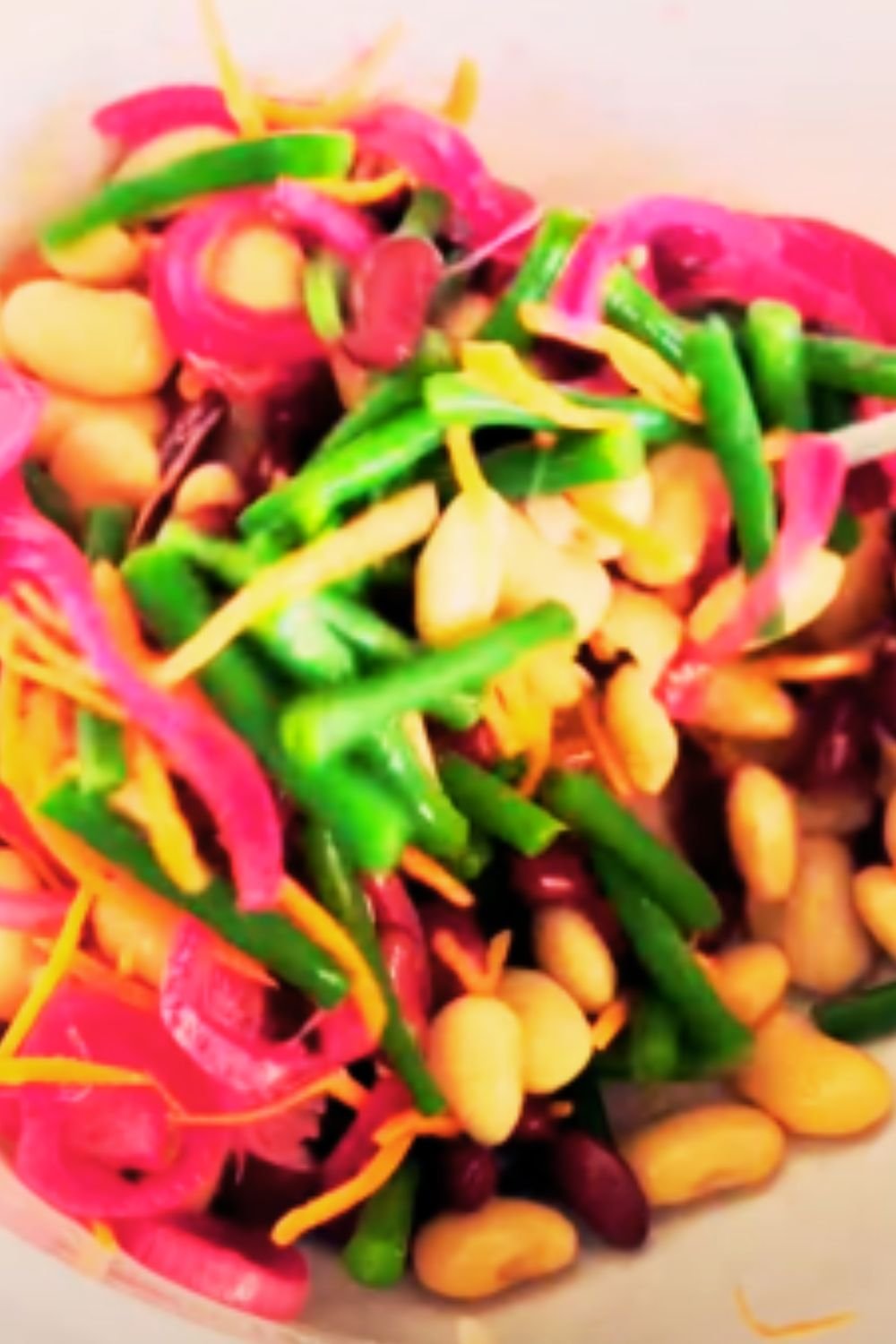When it comes to Middle Eastern cuisine, few dishes capture the essence of freshness and vibrant flavors quite like tabbouleh. As someone who’s spent years perfecting this classic dish, I’m excited to share my authentic Lebanese tabbouleh recipe that stays true to tradition while offering practical tips for modern kitchens.
Tabbouleh (also spelled tabouli or tabouleh) is a bright, herbaceous salad that originated in the mountains of Lebanon and Syria. Unlike many westernized versions that use bulgur wheat as the main ingredient, authentic tabbouleh is predominantly a parsley salad with bulgur playing a supporting role. This distinction is crucial—traditional Lebanese tabbouleh celebrates the herbs rather than the grain.
What Makes Authentic Tabbouleh Special?
I’ve noticed that many restaurant versions of tabbouleh get the proportions wrong, using far too much bulgur and not enough herbs. Real Lebanese tabbouleh should be vibrantly green with just enough bulgur to add texture. The flavor profile is herbaceous, tangy from fresh lemon juice, with subtle nutty notes from the bulgur and olive oil.
What makes tabbouleh truly special is its versatility and nutritional profile. It’s:
- Naturally vegan and vegetarian
- Packed with vitamins and antioxidants from fresh herbs
- Light yet satisfying
- Perfect as a side dish or light main course
- Ideal for meal prep (though best consumed within 24 hours)
This salad is part of the mezze tradition—small dishes served as appetizers or collective meals throughout the Levant region. When I serve tabbouleh at gatherings, I always pair it with other mezze favorites like hummus, baba ganoush, and warm pita bread.
Essential Ingredients for Perfect Tabbouleh
The quality of ingredients makes all the difference in tabbouleh. Here’s what you’ll need:
Fresh Herbs and Vegetables
- Flat-leaf parsley: The absolute star of the show. I use 3-4 large bunches, focusing on the leaves and discarding most stems. Curly parsley works too, but flat-leaf (Italian) parsley provides the authentic flavor.
- Fresh mint: Adds a cooling element that balances the other flavors. I use about 1/2 cup of fresh leaves.
- Tomatoes: Choose firm, ripe tomatoes. Roma or vine-ripened varieties work well as they’re less watery. You’ll need about 3-4 medium tomatoes.
- Green onions (scallions): Provides a mild onion flavor without overpowering the herbs. I use 4-5 stalks, green and white parts.
- English cucumber: Optional but adds refreshing crunch. One small cucumber is sufficient, seeds removed.
Grains and Seasonings
- Fine bulgur wheat: Traditional tabbouleh uses fine bulgur (#1), not medium or coarse. You’ll need just 1/4 cup—remember, authentic tabbouleh is herb-forward, not grain-heavy.
- Extra virgin olive oil: Use the best quality you can afford. About 1/3 cup gives the perfect moisture.
- Fresh lemon juice: Always use freshly squeezed, never bottled. You’ll need about 1/4-1/3 cup or juice from 2-3 lemons.
- Sea salt and freshly ground black pepper: To taste, but be generous with the salt to enhance the herbs.
Optional Enhancements
I sometimes include these for added dimension:
- Ground allspice: A tiny pinch adds subtle warmth.
- Pomegranate seeds: For special occasions, adding a handful brings color and juicy pops of sweetness.
Essential Equipment
For perfect tabbouleh, you’ll need:
- Sharp chef’s knife for finely chopping herbs
- Large mixing bowl
- Small bowl for soaking bulgur
- Citrus juicer
- Colander for washing and draining herbs
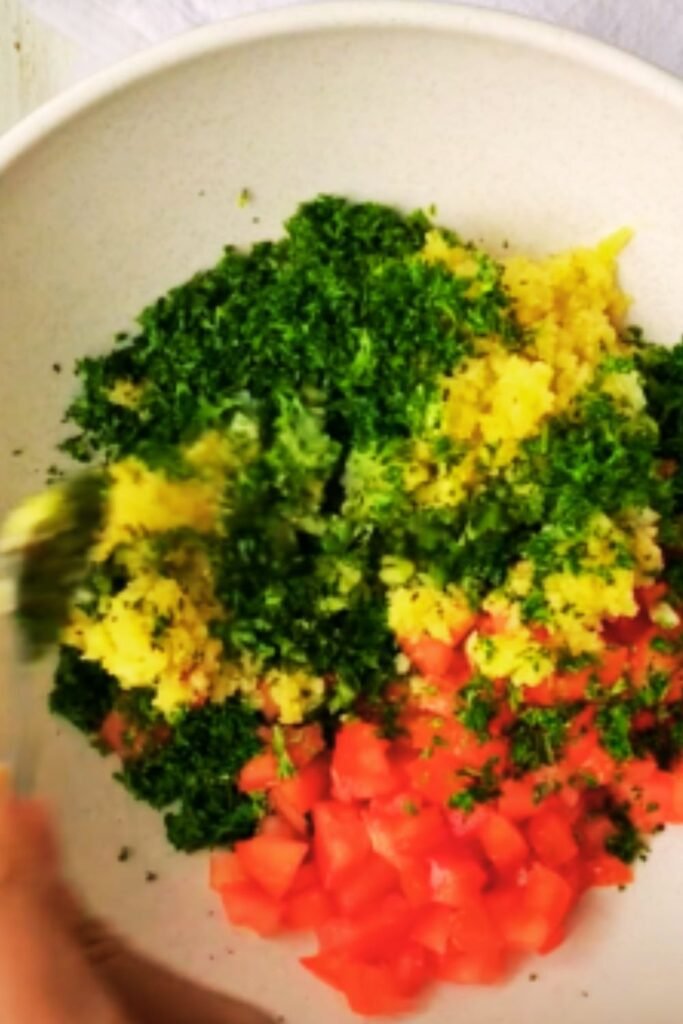
Preparation Method: The Art of Chopping
Proper tabbouleh requires excellent knife skills or patience—the herbs must be very finely chopped, but not pulverized. Here’s my foolproof method:
Preparing the Bulgur
- Place 1/4 cup fine bulgur in a small bowl.
- Pour 2 tablespoons of lemon juice and 2 tablespoons of water over the bulgur.
- Stir and let soak for 15-20 minutes while you prepare the other ingredients.
- The bulgur should absorb the liquid and become tender. Unlike many recipes, we don’t need to cook it!
Chopping the Herbs
- Wash parsley bunches thoroughly in cold water to remove grit.
- Dry thoroughly using a salad spinner or clean kitchen towels. Any moisture will make your salad soggy.
- Pick leaves from thick stems (thin stems are fine to include).
- Gather the parsley into tight bundles and chop with a sharp knife, using a rocking motion. Continue chopping until very fine, but stop before it becomes mushy.
- Transfer to a large bowl.
- Repeat the process with mint leaves, chopping them as finely as the parsley.
Preparing Other Vegetables
- Dice tomatoes into small cubes (about 1/4 inch). Remove excess seeds and juice.
- Finely slice green onions, including both white and green parts.
- If using cucumber, peel partially (leaving some skin for color), remove seeds, and dice into small pieces.
Assembling the Salad
- Add chopped mint, tomatoes, green onions, and cucumber (if using) to the chopped parsley.
- Drain any excess liquid from the soaked bulgur by pressing gently with a spoon, then add to the herb mixture.
- Pour in the remaining fresh lemon juice (about 3-4 tablespoons) and the olive oil.
- Season generously with salt and pepper, plus a tiny pinch of allspice if desired.
- Toss gently but thoroughly to combine all ingredients.
- Taste and adjust seasoning as needed—tabbouleh should be bright and tangy.
Tips for Perfect Authentic Tabbouleh
After years of making this salad, I’ve learned a few tricks:
- Chopping by hand is best: While a food processor might seem convenient, it often turns herbs mushy rather than finely chopped. The texture difference is noticeable.
- Serve at room temperature: Tabbouleh tastes best when not cold from the refrigerator. If you must make it ahead, let it sit out for 15-20 minutes before serving.
- Drain tomatoes: After dicing tomatoes, let them sit in a strainer for a few minutes to release excess juice. This prevents the salad from becoming watery.
- Use a sharp knife: A dull knife will bruise the herbs, affecting both appearance and flavor.
- Adjust lemon to taste: The lemon juice should be prominent but not overwhelming. Start with less and add more as needed.
- Serve with romaine leaves: In Lebanon, tabbouleh is often served with romaine lettuce leaves used as edible scoops!
Nutritional Benefits of Tabbouleh
Tabbouleh isn’t just delicious—it’s incredibly nutritious. Here’s a breakdown of the health benefits:
| Ingredient | Key Benefits |
|---|---|
| Parsley | High in vitamins A, C, and K; rich in antioxidants; supports immune function |
| Mint | Contains menthol for digestion; rich in antioxidants; anti-inflammatory properties |
| Tomatoes | Contain lycopene; source of vitamins C and K; heart-healthy |
| Bulgur | Whole grain with fiber; provides steady energy; contains minerals and B vitamins |
| Olive Oil | Healthy monounsaturated fats; anti-inflammatory; supports heart health |
| Lemon Juice | Rich in vitamin C; aids digestion; alkalizing effect on the body |
| Green Onions | Prebiotic properties; contain allicin which supports immune function |
With only about 150-170 calories per serving, tabbouleh packs an impressive nutritional punch. It’s low in fat while offering plenty of fiber and micronutrients.
Serving Suggestions
Traditional Lebanese meals feature tabbouleh as part of a larger spread. Here’s how I love to serve it:
As Part of a Mezze Platter
Tabbouleh pairs beautifully with:
- Warm pita bread or lavash
- Hummus and baba ganoush
- Stuffed grape leaves (warak enab)
- Falafel
- Labneh (strained yogurt) with olive oil
- Olives and pickled vegetables
As a Side Dish
Tabbouleh complements:
- Grilled fish or chicken
- Lamb kofta
- Vegetable skewers
- Stuffed eggplant or zucchini
As a Light Main Course
For a simple lunch:
- Serve a larger portion of tabbouleh
- Add a protein like grilled halloumi cheese or chickpeas
- Include warm flatbread on the side
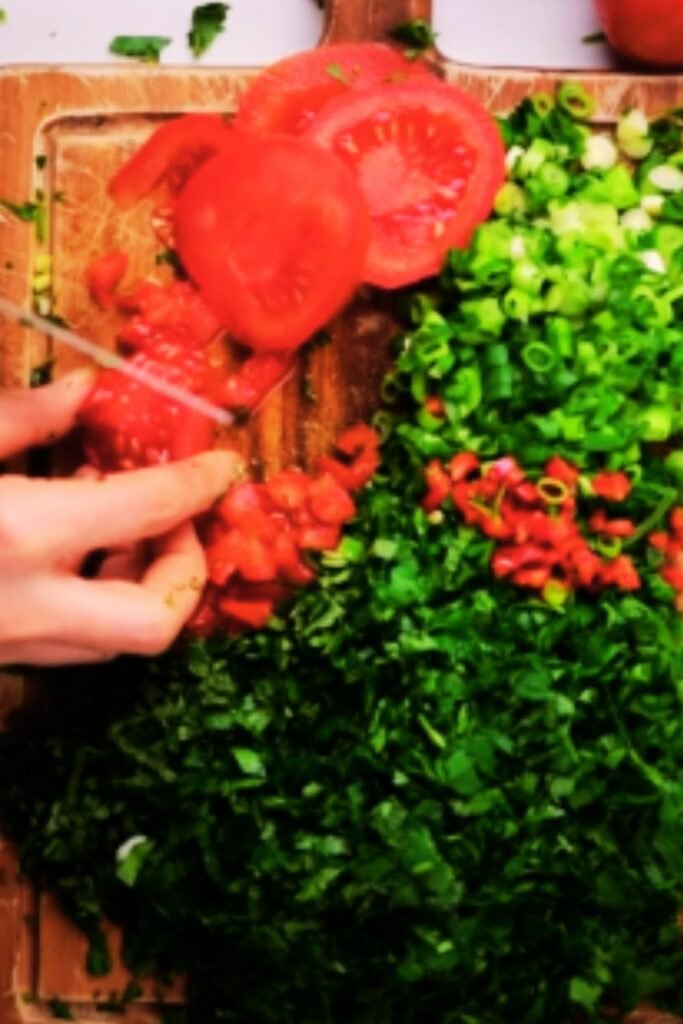
Variations While Maintaining Authenticity
While I’m a purist about the herb-to-grain ratio, there are some variations that still respect the essence of tabbouleh:
Regional Differences
- Turkish-style: Sometimes includes pomegranate molasses for a sweet-sour dimension.
- Palestinian variation: May include more bulgur and sometimes diced bell peppers.
- Armenian tabbouleh: Often incorporates more bulgur and sometimes chopped lettuce.
Dietary Adaptations
- Gluten-free option: Substitute quinoa or millet for bulgur. While not traditional, this maintains the spirit of the dish.
- Extra protein: Add chickpeas (garbanzo beans) for a more filling salad.
Seasonal Adaptations
In summer, when tomatoes are at their peak, I might increase the proportion slightly. In winter, when good tomatoes are harder to find, I sometimes substitute finely diced red bell pepper for color and crunch.
Storage and Make-Ahead Tips
Tabbouleh is best enjoyed fresh, but with a few precautions, you can prepare elements ahead:
- Herbs: Can be washed and dried up to 24 hours ahead, stored between paper towels in a sealed container.
- Bulgur: Can be soaked several hours ahead and kept covered in the refrigerator.
- Assembled salad: Best consumed within 4-6 hours, but will keep up to 24 hours. The herbs will darken slightly and flavors will intensify.
- Storage method: If storing, keep in an airtight container and don’t add all the dressing. Reserve some lemon juice to brighten it up just before serving.
Complete Tabbouleh Recipe
Here’s the complete recipe with measurements:
Authentic Lebanese Tabbouleh
Serves: 6 as a side dish Prep Time: 30 minutes Total Time: 30 minutes + 15 minutes soaking time
Ingredients:
- 3-4 large bunches flat-leaf parsley (about 4-5 cups when chopped)
- 1/2 cup fresh mint leaves (about 1 small bunch)
- 1/4 cup fine bulgur wheat (#1 grade)
- 3-4 medium firm tomatoes, finely diced (about 2 cups)
- 4-5 green onions, finely sliced
- 1 small English cucumber, seeded and finely diced (optional)
- 1/3 cup extra virgin olive oil
- 1/4-1/3 cup fresh lemon juice (from 2-3 lemons)
- 1 teaspoon sea salt, or to taste
- 1/2 teaspoon freshly ground black pepper
- Pinch of ground allspice (optional)
- Romaine lettuce leaves for serving (optional)
Instructions:
- Place bulgur in a small bowl, add 2 tablespoons of lemon juice and 2 tablespoons water. Stir and let soak for 15-20 minutes.
- Meanwhile, wash parsley and mint thoroughly and dry completely.
- Remove thick stems from parsley and chop leaves very finely. Transfer to a large mixing bowl.
- Chop mint leaves finely and add to the parsley.
- Finely dice tomatoes, removing excess seeds and juice. Add to the herbs.
- Slice green onions thinly and add to the bowl.
- If using cucumber, dice finely and add to the mixture.
- Check the bulgur—it should be tender. Press out any excess liquid and add to the salad.
- Pour in olive oil and remaining lemon juice. Season with salt, pepper, and allspice if using.
- Toss gently but thoroughly to combine all ingredients.
- Taste and adjust seasoning as needed.
- Let sit for 15 minutes before serving to allow flavors to meld.
- Serve at room temperature, with romaine lettuce leaves if desired.
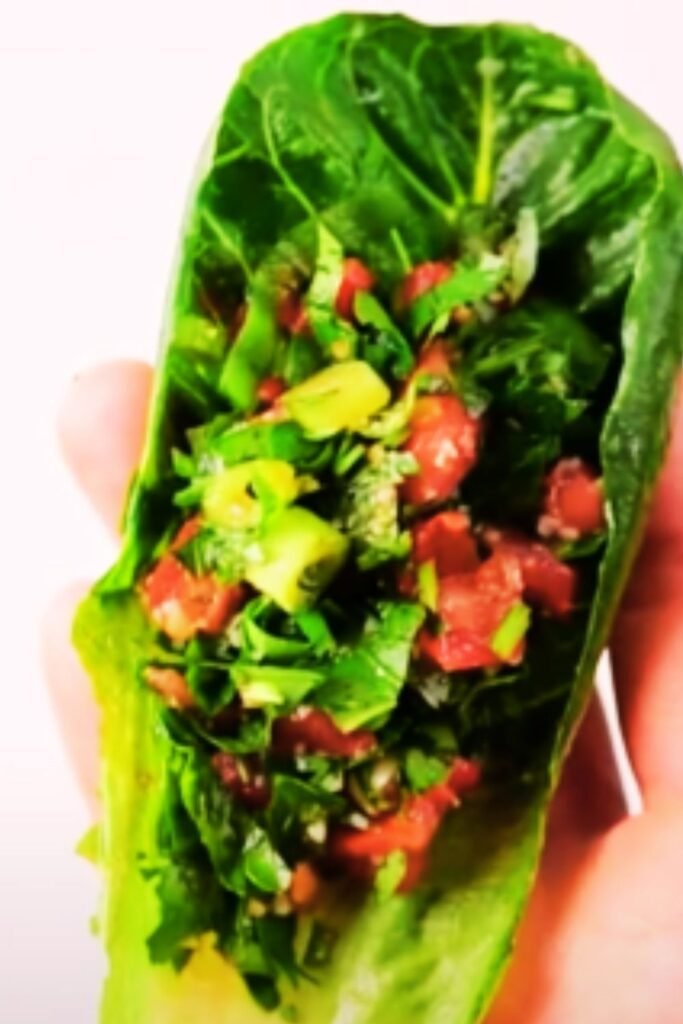
Troubleshooting Common Tabbouleh Problems
| Problem | Likely Cause | Solution |
|---|---|---|
| Soggy tabbouleh | Herbs not dried properly or too much liquid | Ensure herbs are completely dry before chopping; drain tomatoes well |
| Bitter taste | Parsley stems included or herbs bruised during chopping | Use mainly leaves; chop with a sharp knife using gentle technique |
| Too grain-heavy | Too much bulgur used | Remember authentic tabbouleh uses minimal bulgur—just 1/4 cup for a large salad |
| Bland flavor | Insufficient seasoning | Be generous with salt, lemon juice, and good olive oil; adjust to taste |
| Wilted herbs | Dressed too far in advance | Dress the salad no more than 30 minutes before serving for best results |
| Watery bottom | Excess moisture from tomatoes | Let diced tomatoes drain in a colander before adding to salad |
Historical and Cultural Context
Tabbouleh has been part of Lebanese and Syrian cuisine for centuries, originating in the mountains of Lebanon where fresh herbs grow abundantly. The name comes from the Arabic word “tabil,” meaning seasoning or dip.
Traditionally, tabbouleh was a seasonal spring dish when parsley and mint were at their freshest. Today, it’s enjoyed year-round as a staple of Lebanese cuisine and has become popular worldwide as part of the Mediterranean diet trend.
In Lebanon, tabbouleh holds a special place in family gatherings and celebrations. It’s often one of the first dishes brought to the table and served with pride. The meticulous chopping of herbs is sometimes even considered a demonstration of culinary skill.
Questions and Answers
Is tabbouleh healthy? Yes! Tabbouleh is extremely healthy. It’s packed with vitamins, minerals, and antioxidants from fresh herbs and vegetables. The olive oil provides healthy fats, while the minimal amount of bulgur adds fiber. It’s low in calories but nutrient-dense, making it an excellent choice for those focusing on healthy eating.
Can I make tabbouleh ahead of time? While tabbouleh is best enjoyed fresh, you can prepare it up to 24 hours ahead. The flavors will actually intensify over time, though the herbs may darken slightly. If making ahead, you might want to add a squeeze of fresh lemon juice just before serving to brighten the flavors.
What’s the difference between authentic and American-style tabbouleh? Authentic Lebanese tabbouleh is primarily an herb salad with minimal bulgur—the parsley should be the dominant ingredient. American adaptations often reverse this ratio, making bulgur the main component with herbs as an accent. The authentic version has a brighter, fresher flavor and lighter texture.
Can I use a food processor to chop the herbs? While it’s technically possible, I don’t recommend it. A food processor tends to bruise the herbs and creates an uneven texture—some bits pulverized while others remain too large. Hand chopping, while more time-consuming, produces the ideal texture that’s characteristic of authentic tabbouleh.
Is bulgur wheat the same as cracked wheat? No, though they’re similar. Bulgur is wheat that has been parboiled, dried, and cracked, making it quick to prepare since it’s already partially cooked. Cracked wheat is simply broken wheat grains that haven’t been pre-cooked and require longer cooking. For authentic tabbouleh, fine bulgur (#1) is the traditional choice.
Can I make gluten-free tabbouleh? Absolutely! While not traditional, you can substitute the bulgur with quinoa, millet, or even cauliflower rice for a gluten-free version that maintains the spirit of the dish. Just remember to use a small amount to keep the herbs as the focus.
How finely should I chop the parsley? The parsley should be chopped finely enough that you don’t get whole leaves, but not so fine that it becomes mushy. Each piece should be roughly 1-2mm in size. Proper chopping takes time but is essential for authentic texture.
Why is my tabbouleh watery? This usually happens when the herbs weren’t dried thoroughly after washing or the tomatoes released too much juice. Make sure to dry herbs completely using a salad spinner or clean kitchen towels, and consider letting diced tomatoes sit in a strainer for a few minutes to release excess moisture before adding them to the salad.
Final Thoughts on Tabbouleh
Tabbouleh represents everything I love about Mediterranean cuisine—simple, fresh ingredients allowed to shine through minimal preparation. The bright flavors, contrasting textures, and vibrant colors make it not just nutritious but genuinely enjoyable to eat.
What I find particularly special about tabbouleh is how it connects us to ancient culinary traditions while fitting perfectly into modern healthy eating patterns. It’s a dish that has stood the test of time for good reason.
Whether you’re serving it as part of a mezze spread, alongside grilled proteins, or enjoying it as a light meal on its own, authentic tabbouleh brings a touch of Lebanese hospitality to your table. The careful hand-chopping of herbs might require a bit of patience, but the resulting freshness and texture make every minute worthwhile.
I encourage you to embrace the herb-forward approach of traditional tabbouleh—you might be surprised by how refreshing and satisfying a properly made version can be compared to the bulgur-heavy adaptations commonly found in restaurants.
And remember, the best tabbouleh is made with love and attention to detail. Take your time with the preparation, use the freshest ingredients you can find, and share it with people you care about—just as it’s been enjoyed in Lebanese homes for generations.
